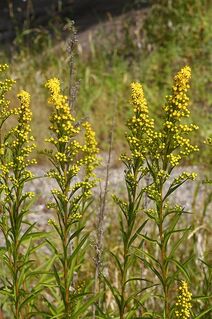Solidago nemoralis
| Solidago nemoralis | |
 | |
| Light: | |
| Moisture: | |
| Soil pH: | 5.6-8.4 |
| Height: | 1' |
| Native to: | |
| Shelter Nectary | |
| Edible Rating: | |
| Medicinal Rating: | |
| Tea: | Yes |
Solidago nemoralis (common names: old-field goldenrod and gray goldenrod)
Propagation: Seed - sow spring in a cold frame. Only just cover the seed and do not allow the compost to become dry. Prick out the seedlings into individual pots when they are large enough to handle, and grow them on for their first winter in pots. Plant them out into their permanent positions in spring or early summer.
Division in spring or autumn. Larger divisions can be planted out direct into their permanent positions. We have found it best to pot up the smaller divisions and grow them on in a lightly shaded position in a cold frame, planting them out once they are well established in the summer.
Cultivation: We have very little information on this species and do not know if it will succeed in Britain, though judging by its native range it should succeed outdoors in many parts of the country. The following notes are based on the general needs of the genus.
Succeeds in any moderately fertile moisture retentive soil in sun or semi-shade[1]. Grows well in heavy clay soils.
A rather greedy plant, it is apt to impoverish the soil[2].
The plant attracts various beneficial insects such as ladybirds, lacewings and hoverflies to the garden, these insects will help to control insect pests in the garden[3][4].
Range: Western N. America - western Montana to central Idaho, south to Colorado and Arizona.
Habitat: Dry open places in foothills, valleys and plains[5].
Edibility: Seed[6][7][8][9]. No more details are given but the seeds are very small and fiddly to harvest[K].
Medicinal: Antiseptic. An infusion of the dried powdered herb can be used[10].
Usage: Mustard, orange and brown dyes can be obtained from the whole plant[10].
Pollinators: Insects
Soil: Can grow in light, medium, and heavy soils.
Drainage: Prefers well drained soil.
Flower Type: Hermaphrodite
Heavy Clay: Grows in heavy-clay soils.
Also Known As: S. nemoralis.
Links
References
- ↑ Huxley, Anthony. The New Royal Horticultural Society Dictionary of Gardening. MacMillan Press, 1992.
- ↑ Chittendon, Fred. RHS Dictionary of Plants. Oxford University Press, 1951.
- ↑ Allardice, Pamela. A-Z of Companion Planting. Cassell Publishers, 1993.
- ↑ Bown, Deni. Royal Horticultural Society Encyclopaedia of Herbs and Their Uses. Dorling Kindersley, 1995.
- ↑ Hitchcock, Leo. Vascular Plants of the Pacific Northwest. University of Washington Press, 1955.
- ↑ Uphof, Johannes. Dictionary of Economic Plants. Weinheim, 1959.
- ↑ Usher, George. A Dictionary of Plants Used by Man. Constable, 1974.
- ↑ Tanaka, Tyōzaburō. Tanaka's Cyclopaedia of Edible Plants of the World. Keigaku Publishing, 1976.
- ↑ Yanovsky, Elias. Food Plants of the North American Indians Publication 237. US Department of Agriculture.
- ↑ 10.0 10.1 Grae, Ida. Nature's Colors. MacMillan Publishing, 1974.